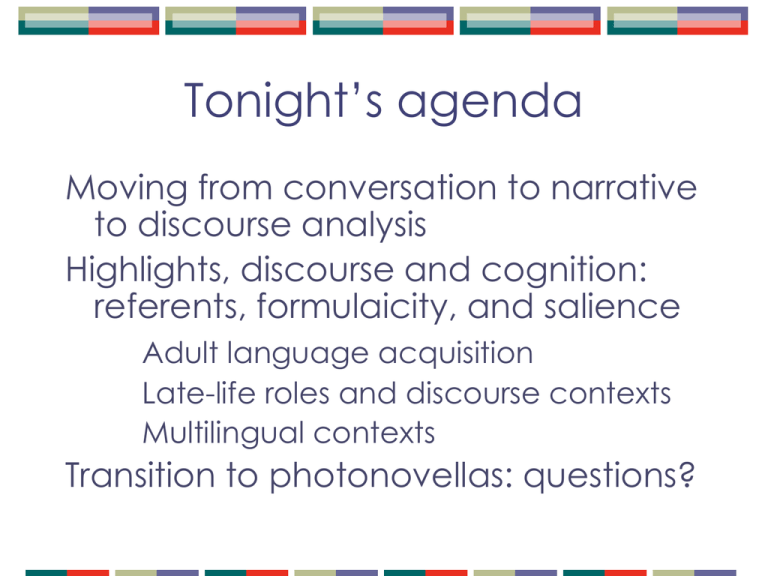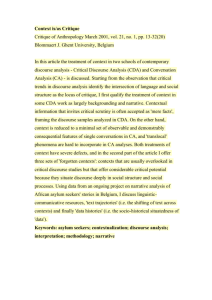discourse - Personal Web Pages
advertisement

Tonight’s agenda Moving from conversation to narrative to discourse analysis Highlights, discourse and cognition: referents, formulaicity, and salience Adult language acquisition Late-life roles and discourse contexts Multilingual contexts Transition to photonovellas: questions? Discourse, salience, and formulaicity edging toward metaphor and figurative language February 20, 2007 Slembrouck on discourse analysis …discourse analysis foregrounds language use as social action, language use as situated performance, language use as tied to social relations and identities, power, inequality and social struggle, language use as essentially a matter of "practices" rather than just "structures" http://bank.rug.ac.be/da/da.htm Focus of discourse analysis discourse analysis is defined as a) concerned with language use beyond the boundaries of sentence/utterance, b) concerned with the interrelationships between language and society and c) as concerned with the interactive or dialogic properties of everyday communication. (Stubbs 1983:1: cf Slembrouck 2005) Some ways discourse connects to cognition: Alterman Theory: Mental representations, planning, situated activity, conversation analysis, joint activity, distributed cognition Method: Ethnography, discourse analysis, marginal talk **joint sense-making **cockpit and air traffic control **models of group interaction **conceptual networks WORDS: Aitchison, 1995. How adults handle wimps (language acquisition) “…there is a deep lack of information about how adults increase vocabulary in their own language, even though native speakers continue to add words to their mental lexicon throughout their lives”, They must also know how a word normally collocates: … Speakers must be able to use a word at the appropriate social level: ….Speakers must know a word's relationship to other words... • wimp-words were learned via: • (a) their frequent occurrence; • (b) their co-occurrence with other words Concordance, collocates (‘bread and___’) and senses were all running round you know going to this dance or pboard romance but and ah was going to get married to this clears throat ; what I 'm going to ask you now is a it's a school photo of - I was going to show it to you white apron and ah when she was going to cook or make butter g white apron came out . and ah going to milk the cows she there thinking now what are we going to have for dinner ? “strings of specific lexical items... that cooccur with a mutual expectancy greater than chance” (Nattinger and de Carrico 1992) how do we store these? Retrieve them? In chunks, in collocates, in ‘families’… JOINT ACTION in discourse: taking the perspective of the other In joint action, as a speaker, I have to monitor for what • you signal you need to know (via ‘backchannels’) • I infer you probably need to know, if you are to follow and understand what I’m saying/about to say, keyed to • common ground that I assume we share from recognizing referents • the ‘newness’ of the information I will tell you Impairments (i.e. AD) may interfere with our inferencing Discourse referents: The speaker activates referents in the mind of the hearer. Bada Bing. Because of current TV shows, I think we have shared knowledge and common ground about that expression and that as soon as you hear me say Bada, you can predict the –ing in Bing, re-activate it before I finish saying the B, and you can monitor your success before the next word. Are referents limited to being single words only? No. They can be schema • See ring-composition in the Iliad, Odyssey, or Beowulf • See guidelines for proposals, grants, theses…. They can be idioms, metaphors, proverbs, multiword expressions or formulaic language how do you identify what the referent is (or isn’t)? It has to be shared directly or indirectly by association [which is where culture can sneak in: ‘lions and tigers and bears – oh my!’ is a Scout song and a line from Wizard of Oz, but not universal knowledge outside the US] It has to be contextually salient Discourse Tracking: the conversation/story Now it gets a little more complicated. How long ago does the hearer have to have ‘heard’ the referent to be able to pull it up fast and keep tracking the conversation? What part or kind of memory did the referent get stored in? How much will it cost in terms of processing ‘cost’ to access it and keep it going (active and given) or re-activate it (semi-active and accessible)? Or does the hearer have to construct it brand new from implicature and inference? That is way expensive and it might be way slow. Hmm. Larger units/bigger blocks and parallel processing might help fluency Diane Van Lancker-Sidtis (2004) on fluency “Paradoxically, true creativity in language consists not in generating ever new sentences, but in mixing old (formulaic and overlearned) and new. Each mode, propositional and non-propositional, places different processing demands on speech production and comprehension. Production of propositional expressions requires lexical retrieval and arrangement according to grammatical rules; non-propositional production involves activating and retrieving prepackaged units or schemata. … Multiword formulaic expressions are ‘‘‘ready to speak,’’ thus facilitating fluency’ (29) vanLancker-Sidtis & Rallon 2004: tracking formulae in everyday speech. Yes, we use them. The incidence of FEs in a screenplay, Some Like It Hot, was examined, and found to make up nearly 25% of the phrases in the text.…. Sorhus (1977) reported about 20% formulaic expressions in a Canadian sample of spontaneous speech. Using computersearch criteria, Altenberg (1991, 1998) estimated that London-Lund Corpus (Greenbaum and Svartik, 1990) contained 80% recurrent word-combinations. … Start with When novel sentences are not enough…toward a dual-process model of language. International Journal of Language and Communication Disorders 39, 1–44. Kecskes (2003) SBU and formulaicity situation-bound utterances (SBUs): SBUs are highly conventionalized, prefabricated units whose occurrence is tied to more or less standardized communicative situations (1999) –we’d call them formulaic expressions (like ‘black sheep’) While it used to be maintained that sentences were freely generated, the identification of SBUs confirms that many prefabricated sentences and phrases, tied to specific situations, belong to the lexicon. Situation-Bound Utterances in L1 and L2 (2003): [See review by Cooren 2004, Pragmatics and Cognition 12, 177 ff Wray (2002): Formulaicity in L1 lexicon Formulaic language and the lexicon. Cambridge U. Press Kecskes explains (Giora’s) Graded Salience Hypothesis In terms of processing, stored information is superior to unstored information such as novel information or information inferable from context (Giora, 2003: 15). As a consequence, salient meanings of lexical units (e.g. conventional, frequent, familiar and prototypical) are processed automatically, irrespective of contextual information and strength of bias. The Graded Salience Hypothesis assumes: The GSH assumes that the modular, lexical access mechanism is ordered: more salient meanings – coded meanings foremost on our mind due to conventionality, familiarity or frequency – are accessed faster than and reach sufficient levels of activation before less salient ones. (The salience directs our attention and our limited perceptual resources) Discourse salience, contexts and roles across the lifespan Those contexts in which we learn new words and new senses of words throughout our lives are what we are calling discourse contexts New discourse contexts index new discourse roles New roles bring about new contexts Power roles and power squeezes: names & the sandwich generation Family roles define power (text p 79), which changes throughout the lifespan. Sandwich power may be power squeeze Traditional: those sandwiched between aging parents who need care and/or help and their own children. Discourse roles? Club Sandwich: those in their 50s or 60s, sandwiched between aging parents, adult children and grandchildren. OR Those in their 30s and 40s, with young children, aging parents and grandparents. Discourse roles? Adult relationships change Having a sister is like having a best friend you can't get rid of. You know whatever you do, they'll still be there. ~Amy Li Is solace anywhere more comforting than in the arms of a sister? ~Alice Walker Big sisters are the crab grass in the lawn of life. ~Charles M. Schulz It takes two men to make one brother. ~Israel Zangwill I don't believe an accident of birth makes people sisters or brothers. It makes them siblings, gives them mutuality of parentage. Sisterhood and brotherhood is a condition people have to work at. ~Maya Angelou Example: We’re getting older; NEJM 1994 was tip of iceberg From 1960 to 1990, the number of Americans 85 years of age or older increased by 232 percent, whereas the number 65 years of age or older increased by 89 percent and the total population grew by just 39 percent. Currently [1994], 3.5 million U.S. citizens are 85 or older. In this age group, known as the oldest old, women outnumber men by 2.6 to 1. Language stereotypes for gender and aging, anyone? Oldest old now use fewer nursing homes: use community instead Learning how to maintain relationships becomes more crucial What ‘small stories’ do you see in Frost’s poem? The witch that came (the withered hag) To wash the steps with pail and rag Was once the beauty Abishag, The picture pride of Hollywood. *** No memory of having starred Atones for later disregard Or keeps the end from being hard. Better to go down dignified With boughten friendship at your side Than none at all. Provide, provide! Story genres and positioning: Brockmeier & Harre …our local repertoire of narrative forms is interwoven with a broader cultural set of fundamental discursive orders that determine who tells which story, when, where, and to whom. Stories are told from ‘positions’ … articulations of particular narratives from particular points of view and in particular voices Those positions change over a lifetime, and so do our particular choices of words. When do we add them? When and how do we lose them? An example: Burke and Shafto 2004 Experimental research and older adults’ reports of their own experience suggest that the ability to produce the spoken forms of familiar words declines with aging. Older adults experience more word-finding failures, such as tip-of-the tongue states, than young adults do, and this and other speech production failures appear to stem from difficulties in retrieving the sounds of words. Recent evidence has identified a parallel agerelated decline in retrieving the spelling of familiar words. … We describe a model [transmission deficit] wherein aging weakens connections among linguistic representations, thereby reducing the transmission of excitation from one representation to another. B&S: Node activation, ‘pylon’ Burke & Shafto: findings ‘Although older adults maintain or improve their knowledge of words and word meanings, they suffer deficits in the ability to produce the spoken and written forms of words. The transmission-deficit model provides a framework for understanding this pattern of language change during adulthood, and points to important areas for future research. Inasmuch as these production deficits are caused by weak connections in the phonological and orthographic systems, recent and frequent word production should improve subsequent performance.' Current directions in psychological science 13 New directions: Source memory, aging & culture Chua, Chen and Park 2006 Review, de Bot & Makoni 2005: Language & aging in multilingual contexts …many older people, and especially those speaking more than one language, are aging out-of-place, dis-placed, cut off by new caretaking venues and other-languaged caregivers, from their own places, those sites once indexed by their language (Lamb 2000; Neilson 2003). As Arjun Appadurai comments in an interview, “sites, in the sense of secure locations for the practices of everyday life, may have largely vanished” (Appadurai Interview by Baldauf & Hoeller 1999). What we have previously assumed about adult language, and about language and aging processes, may also need to change.








